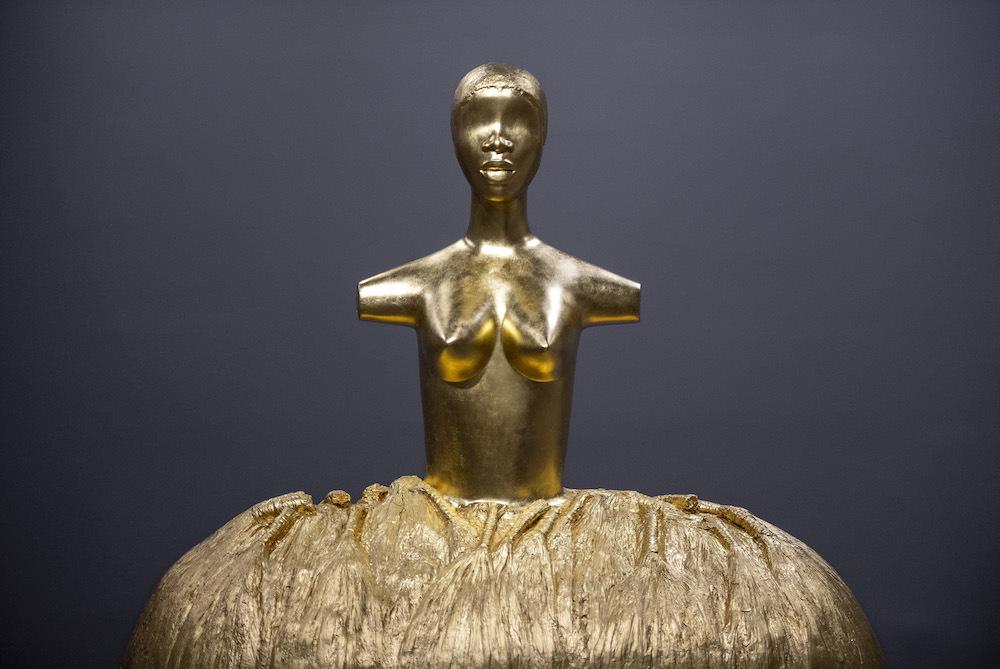Three Major Shows: Starring Black Women Artists
Right now in Los Angeles, we have the gift of important shows of three major contemporary Black women artists. Try to see them all, as this fortuitous alignment of stars may not happen again, at least not anytime soon. There’s Simone Leigh at LACMA and the California African American Museum, a shared survey show till January 20, 2025; Zanele Muholi at Southern Guild till August 30 and Mickalene Thomas at the Broad till September 29. All three use the Black female image—in celebration, in sisterhood, in joy and sometimes sorrow—and always in ways that make us pay attention.
“Simone Leigh” is a two-decade survey of Leigh’s work in ceramic, bronze, video and installation. It’s a traveling exhibition organized by the ICA Boston, and Los Angeles is lucky enough to be one of the stops (although I rather wish it had all been at a single venue to concentrate the experience). Her sculptures are powerful, elegant and enigmatic, often larger-than-life representations of Black women. They tend to be iconic, with Black facial features, but the eyes are missing.
Also covering about two decades of artistic output is “Mickalene Thomas: All About Love,” an internationally touring exhibition of 90-some works that burst in a swirl of color and imagery. Thomas’ works are exuberant and joyful celebrations of the lives of Black women, including mixed-media painting, collage, installation and photography. They reference and incorporate magazines, advertising and books pivotal to the Black female experience—such as Jet magazine and text by bell hooks—calling for love and healing toward collective liberation.
The biggest surprise for me was the artist I knew only through a few photographs appearing in articles, the South African artist Zanele Muholi. The current show at Southern Guild, a South African gallery that recently built an outpost in Melrose Hill, opened my eyes to her star quality as an artist with, both an elevated vision of what art can express and deep knowledge of how to work with materials.
Muholi is especially famous for photographic auto-portraits, in the manner of Cindy Sherman and Yasumasa Morimura. However, while those two were pioneers in the field, Muholi has surpassed them in the eloquence and depth of her vision—perhaps because she has had to struggle so much harder to become a recognized artist: Muholi was born a woman and exists as a queer person in a strongly male-dominated society.
A heroic bust on a pedestal and a large black-and-white blowup greet the visitor upon entry. The next gallery holds several highlights, including a series of photographs in which she integrated a found object or objects into her wardrobe—be it swim goggles or Instamatic cameras strung around her like necklaces. In these images she plays with the exoticism projected onto nonwhite women, then subverts that notion with the use of everyday objects as bodily adornments.
“Race politics is central to my work,” Muholi says during a walkthrough of the show. And gender politics, too, she adds. This walkthrough is with a younger audience, including students, and I was impressed that she asked them questions, too. Clearly she loves the public conversation about art as much as the private art-making.
In the corner of the room is the show-stopping Umphathi (The One Who Carries) (2023), a giant version of the female reproductive organs in polished bronze, suspended in midair by wire. It’s an interpretation, a particularly beautiful and poetic one, with the fallopian tubes curling around like two arms towards ovaries, their hands—yes, she made the ends of the tubes into hands—gently reaching towards them. “This is where we all come from,” she says, indicating that it’s something important for us to remember.

Rebecca Campbell, Hollywood is a sign, 2023. © Rebecca Campbell. Courtesy of L.A. Louver.
On Other Fronts
At the end of May, David Zwirner opened his third building in Los Angeles—a ground-up construction designed by Selldorf Architects, led by Annabelle Selldorf. The three buildings on Western Avenue are adjacent, and the first two were existing ones that have been renovated. The new building has over 15,000 square feet of sleek exhibition space—the size of a small museum—and is currently hosting a 30th-anniversary exhibition featuring their roster of artists. And what a list it is! In one room alone were works by groundbreaking artists Anni Albers, Ruth Asawa,
Gordon Matta-Clark and Richard Serra, who is represented by a drawing—and who recently left us.
Rebecca Campbell reaffirms that she is one of our best realist painters in her latest show at L.A. Louver, “Young Americans” (through July 20). On the far wall of the main gallery is a series of 15 portraits of young people—those perched on the edge of adolescence and teendom. Campbell is adept at using turquoise and reds in her underpainting and her outlines, creating a vibrating quality to their faces. These portraits are especially arresting for their tenderness, perhaps reflective of her feelings towards her children (who appear in three of them) and their friends. She conjures a vivid sense of how lovely it is to be on the precipice of so much promise.


